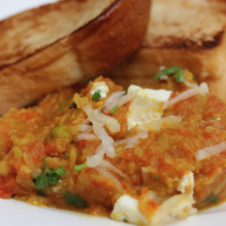Pav Bhaji: A Classic Indian Street Food Dish
Before we get to the Pav Bhaji recipe, some context for you. A much-needed Christmas break finally came and then went. Fast. I went to India for around three weeks. It was very relaxing. Now I’m back at school, and our semester ends later this month, so there’s a ton of tests, projects due, assignments, etc. On long, busy winter days, I find my mind reminiscing about the honking cars and howling dogs that kept me awake past midnight.
Or the huge billboards in Bhopal that all showed the same politician, whose face got on my nerves. I find myself missing the colors, the people, and most importantly, the smells of food that drift from just about everywhere. I have never had better Aloo Paratha outside of my grandmother’s house. I have never tasted butter better than Amul. Crisp Dosas, puffy puris, juicy mutton and bright red carrots. What more could anyone ask for?

Classic Pav Bhaji
Ingredients
For Bhaji:
- ¾ cup chopped green beans
- 3 large fresh tomatoes chopped
- 1 broccoli stalk chopped
- 1 cup chopped ash gourd (also known as winter melon) or pumpkin
- 4 large potatoes, peeled and chopped
- 1 cauliflower head, chopped
- 2 carrots, chopped
- 1 tsp turmeric powder
- 1 tbsp salt
- 1 medium sized onion, chopped
- ¾ cup boiled peas
- 2 tbsp oil
- 1 tbsp butter
- 1 tbsp crushed/grated garlic
- 3 tbsp pav bhaji masala- can be purchased at any Indian food store
For Pav:
- 2-3 tbsp butter, 1 tbsp for each batch
- 8 bread rolls, dinner rolls and buns work nicely, but you can use regular sliced bread
Instructions
- Place all the vegetables except peas, garlic and onions in a pressure cooker. Add the turmeric and salt, and cook for around 20 minutes or until everything is cooked through.
- Once the vegetables are cooked, mash them not too finely- you still want a couple chunks.
- In a saucepan, combine the butter and oil. Once the butter is bubbly, add the garlic and sauté slightly until the garlic becomes golden brown.
- Add the chopped onion and cook till translucent.
- Add in the masala, cook till it is incorporated fully, and then add in the vegetable mash. Stir everything together, then garnish with lemon slices, chopped onions, grated radish and/or paneer (Indian cottage cheese).
- For the pav, melt 1 tbsp of butter in a pan. Cut the bun/ roll in half, horizontally and gently rub both sides in the butter- basically, fry the bread in the butter. 1 tbsp is enough for 4 halves- do it all at once. Flip the bread and press it down with the back of a spatula every once in a while until both sides develop a golden brown color and are slightly toasted. Serve warm with Bhaji.
Notes
What’s for dessert? If you need something quick, try this Coconut Ladoos recipe. Or if you’re looking for something a little more intricate, try this delicious No-Bake Mango Cheesecake recipe!


Hey Vedika! I just happened to come across your blog five minutes ago and I am awestruck! I would never have imagined myself learning Pav Bhaji at 16. I am attempting to make this tomorrow for dinner and I shall definitely post back as to how it turned out! Keep writing =) I’m looking forward to seeing a lot more from you!
Thanks so much for your kind words, Sonia! I’m happy you found this recipe. Do let me know how it works out- this is always the dish I look forward to when I meet my grandparents 🙂
Malonu skaityti!
Guys, Thanks For sharing this Great Recipe. My Family Loved it. I am definitely sharing this recipe and this website with my friend. Hope they also love it. Thank you again for sharing such a great recipe.
Thanks, Ashok!